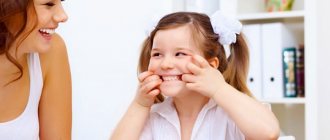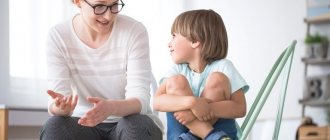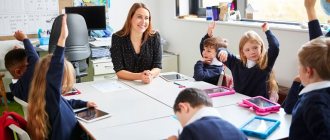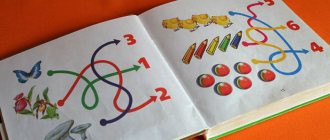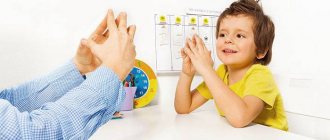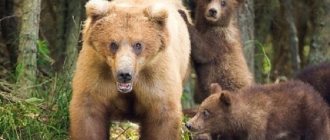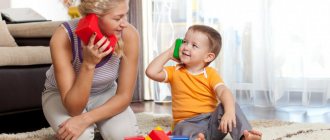Speech development: toys.
Materials for speech and activities with children on the topic “Toys”.
In this article, I continue to talk about how you can develop a child’s speech through play and what speech activities with children can be done at home or in a children’s center or kindergarten. All the games about toys in this article are intended primarily for children 3-4 years old, but they will be interesting and useful for both younger and older children.
- There is no need to strive to play as many games as possible at one time. On the contrary, the game should be ended when the kids are still interested and want it to continue.
- All games are fun, mischievous, interesting, and this is how they should be played with kids - not as serious lessons, but as interesting educational family leisure time, with a smile, with enthusiasm, with humor.
I wish you joyful communication with the kids! Play and have fun!
Speech game with toys 1. “Guess which toys are gone”
We teach the child to use words - the names of toys in the genitive plural.
Meet me! This is brother and sister. Their names are Tanya and Vanya.
Tanya and Vanya have a lot of toys. Look at the picture and name Tanya’s toys (dolls, nesting dolls, jump ropes, bears, ducklings, pyramids).
Let's play with Tanya's toys. I will hide the toys, and you can guess what is missing (cover one picture with your palm or finger and ask: “What is missing?”). The child tries to guess and answers: “There are no more dolls.” If you use a set of pictures, then simply remove one picture, and the child can guess what is missing.
Be sure to praise your child and rejoice with him at the correct answer. If your child made a grammatical mistake (for example, he said: “there are no more jumping ropes or ducklings”), do not repeat the mistake after him. Instead, immediately say the correct option: “You guessed right. Well done! There are no jump ropes."
Now look at Vanya’s toys. What toys does Vanya have? (Cubes, drums, planes, cars, balls, shovels, horses). Let's play with them (“there are no more cars, balls, etc.”).
pictures of toys that can be used for this game in the article “Pictures: Children's Toys”, which will be published tomorrow. All the pictures are of good quality, they can be printed on a printer or included in a presentation, made into a game of paired pictures, or viewed with children and asked riddles.
You can also use real toys for the game (two bears, two cubes, etc.)
A thematic selection of games and exercises for children on the topic “Toys”
Thematic selection of games and exercises
for children on the topic “Toys”
Goals:
Enrich children's active vocabulary with words-names of toys. Form stable ideas about size, shape, color, quantity. Continue to introduce children to geometric shapes. Teach children to make a whole from parts. Introduce children to an unconventional drawing technique - drawing with cotton swabs. Improve the ability to draw straight lines with a pencil, paste image details in the right place. Develop thinking, fine and gross motor skills. Practice onomatopoeia, the ability to navigate in space, and coordinate movements with words. Improve concentration and attention span. Cultivate a caring attitude towards toys.
Didactic game “Find the shadow of the toy”
— The toys have lost their shadows. Find the shadow of each toy and place the colored toy on top of its black shadow.
Didactic exercise “Cut pictures”
“But these toys were unlucky - the children played with them badly and broke them.” Let's fix these toys - connect the parts into a whole.
Didactic game “How many nesting dolls?”
- Here are boats for nesting dolls, but you can put as many nesting dolls in a boat as the number you see on the boat. If there is a number “1” on a boat, it means that only one nesting doll can be placed in this boat. And if the number “2” is on the boat, then you can put two nesting dolls in such a boat. Take the boats and place the nesting dolls.
Didactic game “Matryoshkas went to the forest”
— Matryoshkas love to go for walks in the forest. Now take the matryoshka doll and take it for a walk. (Children manipulate a matryoshka toy on a sheet with glued bridges across a river, tree stumps, and berry bushes).
Here comes the nesting doll. And in front of her is a river. Are there bridges? How many bridges? Two bridges. Identical bridges? No. Various bridges. One bridge is narrow and the other is wide. The nesting doll walked along the narrow bridge. She got tired and sat down to rest on a narrow stump. Uncomfortable on a narrow stump, the nesting doll moved to a wide stump. And here are the bushes with berries. There are many berries on one bush. And on the other there is little. The matryoshka approached a bush with few berries. She collected all the berries and counted them: one, two, three. Then the nesting doll went to a bush with a lot of berries. It's time for the nesting doll to go home. She walked home along the wide bridge. Goodbye!
Drawing with cotton swabs “Berries for matryoshka”
— The nesting dolls wanted to collect the berries in baskets and bring them home. Let's draw some berries. And we will draw berries with cotton swabs.
Application "Cheburashka"
— To complete the portrait of Cheburashka, you need to glue on the missing parts: ears and bib.
Construction "Tumbler"
- Here is a drawing of Tumbler. Let's make it beautiful and bright with colorful circles. Select circles of the appropriate size and apply them to the drawing.
When the children have laid out an image of a tumbler out of circles, you can offer to decorate the body - the children decorate a large circle with multi-colored pebbles and put a circle-face on a circle-head.
Visual activity “Tumbler”
- Let's make beautiful eyes for Tumbler: make two balls of plasticine, attach them to the picture, put the finished eyes on top of the plasticine and press them with your finger. And now, using finger paints, we will make a beautiful red dress for Tumbler.
Outdoor game "Carousel"
Barely, barely, barely the carousel began to spin, And then, then, then, Everyone ran, ran, ran. Hush, hush, don't rush, stop the carousel! One and two, and one and two, The game is over!
Game with clothespins “Rattles”
— The sticks on the rattle toys were broken. Make them from clothespins. (As the children complete the task, the teacher asks what color rattle sticks the children choose).
Didactic game “Find pairs for toys”
Children are given toys and asked to go to the “store” and buy another exactly the same toy.
Dynamic pause "Flag"
— Guys, choose your flags. What color flag did you choose? And you? What color is your flag? Listen to the song and repeat the movements.
Game with buttons "Flags"
— Place the buttons in the right places.
Drawing with pencils “Sticks for flags”
- These are some beautiful multi-colored flags.
Didactic exercise “Find geometric shapes in the picture”
- Look, some figures have run away from this beautiful picture.
- Here is a triangle, a circle, a square, a rectangle, and you return these figures to their places in the picture.
Exercise “Find toys in cereals”
Children dig out small toys from a container filled with cereal.
Didactic game “Build a tower of cubes”
— Build a tower out of square cubes. Name the color of each cube.
Relay race “Put the toys in their place”
Children run one after another from one end of the room to the other, take a toy, return and put it in the chest.
Speech game with toys 2. “Teams”
We teach the child to use verbs in the imperative mood in speech. We prevent and correct grammatical errors in children's speech.
Tanya and Vanya's toys love to follow their commands. Let's teach your toys to perform different commands.
Ask your child to choose a favorite toy to teach. The toy (in the hands of an adult) carries out the baby’s command only if he has not made a grammatical error. In case of an error, the toy “wait” for the child to correct his mistake himself or with the help of adults.
First, you help the child give commands to the toy: “Ask the doll to dance, lie on its back, sing, etc.”, then the child comes up with the commands, and you only help him, suggest the correct option if necessary. In the future, you can change roles with the child.
Below I give a selection of words that children very often make mistakes and say, for example, like this: “lie down”, “wave”, “sing”, “wake up”. These mistakes will very quickly disappear from children’s speech after our fun game. The main thing is to repeat the game many times with different toys and different teams. Commands can be made by an adult, a father and mother, or a child at your request - come up with your own options! Have fun playing!
Sample commands for playing with a toy: sit down, bend over, wave your hand, sing, dance, draw, run, jump, sleep, wake up, clap your hands, stomp, lie on your back, lie on your tummy, comb your hair, ride, sit, jump over ..., touch your nose (ears, tail, mouth), etc.
Speech game with toys 3. Bunnies
Let's get acquainted with toy bunnies: part 1.
We teach kids to describe pictures of toys, compare, analyze, use verbs exactly according to their meaning (distinguish between perfective and imperfective verbs), use diminutive suffixes (baby, bunny, hare, hare, eyes, ears, tail, etc. ).
To play, you will need a picture or three toy bunnies, which you will dress in different ways. These can be bears, dolls and any other toys instead of bunnies.
The first bunny is Shustrik. He is wearing a jacket and trousers. The second is Toropyzhka. He is wearing a jacket that is buttoned incorrectly - as a result, one bottom edge is higher than the other, sticks out unattractively, his hat is on his side, his scarf is tied sloppily on his side. The third one is Catch-up. He hasn't had time to get dressed yet, he's only wearing trousers.
Look at pictures or toys with your child and tell him a story about three bunnies.
“Vanya and Tanya live with three toy bunnies. The first bunny is always in a hurry, in a hurry and therefore does a lot of things wrong. That’s what the guys called him – Toropyzhka. Find it in the picture. How did you guess that it was Toropyzhka?
The second bunny does everything deftly, skillfully, quickly, correctly, smartly. Can you guess what his name was? What would you call an agile, nimble bunny? Interesting names you came up with! Do you want to know what Tanya and Vanya called him? They called him Shustrik because he was very... (smart).
The third bunny is always late, does not have time, and does things very slowly and leisurely. They often tell him: “Catch up with us.” That's why they named it - what do you think? Give him a name that makes it clear that he does everything slowly. What would you call such a bunny? (Encourage any option the child has - this is his word creation, and offer your own options). And Tanya and Vanya called him that - Catch-up.
Find Shustrik and Catch-up in the picture. How did you guess that this is Shustrik, and this is Catch-Up (the child explains).
Playing riddles: part 2.
These toy bunnies are brothers. They are very similar to each other. How are they similar? (They have long ears, short tails, round eyes, small noses, they are white, fluffy, they can jump, they love carrots, etc.).
How are bunnies different? (Look at clothes, shoes, eyes, noses, what the bunnies do).
How can you call a bunny affectionately? (Bunny, bunny, bunny, bunny).
What is the affectionate name for a bunny's ears? Yes, ears.
What is an affectionate name for your nose? (nose).
Eyes - ? (eyes)
Paws - ? (paws)
Tail? (tail)
Let's play riddles. I'll wish for a little bunny, and you guess his name.
You describe a bunny - a toy or a bunny from a picture, and the child must guess his name.
“This little bunny is very cheerful. He has big blue eyes. The bunny's nose is black and small. The bunny's ears are long and his tail is short. He is wearing a red jacket and blue trousers. The jacket has a blue collar and many round buttons. The little bunny loves to sing songs. Who is this?"
Now tell me a riddle: “My little bunny... He has.... The eyes of a bunny... The little bunny has a nose... Bunny loves...” (We help the baby construct a statement - a description, giving him support - the beginnings of phrases).
Who does what: part 3.
Every morning Tanya and Vanya play with the bunnies. Look at the toys (act out a scene). Toropyzhka and Shustrik have already gotten out of bed (we show), and Catch-up is still getting up. And it always happens. Listen and guess who is doing what (the child finishes the end of the phrase by analogy).
- Shustrik has already washed his face, and Catch-up is still... (washing himself).
- Shustrik has already gotten dressed, and Catch-Up is still...(getting dressed).
- Shustrik has already brushed his teeth, and Catch-Up is still...(cleaning).
- Shustrik has already had breakfast, and Catch-up is still...(having breakfast).
- Toropyzhka and Shustrik are already getting ready for a walk, and Catch-up is still...(getting ready).
Lesson summary "Toys" in the middle group
Summary of a lesson on speech development on the topic “Toys” in the middle group
Direct educational activities in the middle group
Topic: Toys.
Target:
practicing the ability to form adjectives; correlate nouns with adjectives in gender, number, case; Expansion and systematization of vocabulary; Dictionary: rubber, iron, glass, cardboard, plastic; Cultivate a caring, friendly attitude towards toys; teach children to put their toys away after themselves.
Equipment
: pictures of toys; a wonderful bag of toys; Mashenka doll; toys: bunny, spinning top, boat, kite, lantern, Teddy bear with a bow (for beauty).
Progress of direct educational activities
1. Organizational moment
(task for children).
Cutting pictures - make a picture from parts and name it. - Guys, what do you think we will talk about today? About toys. All toys are made from different materials. And today we will talk about what toys are made of and what they are like. 2. Studying new material.
Game: Wonderful bag.
Children take out toys by touch and name them; then determine the material from which they are made. - What did you get? - ball. -What is it made of? - made of rubber. - So what kind of ball is it? - rubber ball. Questions clarify the answers: rubber ball; glass ball; wooden cube; iron soldier; plastic scoop; cardboard fish. It is important to ensure that children give complete answers. Game: Let's help the doll Mashenka.
A sad doll Mashenka appears - Why is Mashenka so gloomy, so sad?
All her toys have run away because she doesn't know what they are made of. Let's help Mashenka. We need to find toys and name what they are made of and what they are. Children find toys in the play corner and return to the teacher. You need to name the toy and say what it is. (I have a fur hare; an iron spinning top; a blue ship; a beautiful Bear; a big snake). - Mashenka, do you remember? Tell me what the toys are made of? - Children, did Mashenka answer correctly? - Why isn’t it right? — She didn’t name the material, didn’t say what the toys were made of. - Let's remember once again what kind of toys Mashenka has and what they are made of. Children answer using relative adjectives. 3. Physical education minute.
- Guys, you have all been turned on with a key, you are wind-up dolls (the children walk around pretending to be wind-up dolls).
And now you are bunnies (children jump, imitating bunnies). And now you are bears (imitation). And now the foxes (imitation). And now all the balls are big and small; boys are big and girls are small balls; and they jump in different ways: big ones - high, small ones - lower (then they changed: the girls became big balls, and the boys - small ones). 4. Fixing the material.
Game: Toy Store.
Children look at toys on the shelf. Play activities: children go out and buy the toy they like. Condition: buy only toys made from the same material. First, they buy wooden toys. You need to name it, say what it is, what the toy is made of. — I bought a wooden spoon. I bought a wooden nesting doll. I bought a wooden horse. I bought a wooden cube. — The wooden toys are all gone, they’re all sold out. And now they sell rubber toys. Then plastic toys go on sale. Then iron ones. The teacher asks the children to help, clean up the store and place the toys on the shelves; the children arrange the toys, classifying them. - Well done, guys, you behaved well in the toy store today, played carefully with them, carefully placed the toys on the shelves. Reflection: Children, did you like the toy store? What toys were the most fun to play with? 5. Summary.
Closing conversation. — Guys, what other toys and what materials do you know? Yes, guys, today you learned a lot of interesting things about toys, you played happily and amicably with different toys. The teacher praises the children for their attentiveness and complete answers.
Speech game on the topic “Toys” 4. “How we play”
We learn to select actions (verbs) to an object (noun).
Tanya and Vanya love to play with toys. And they want to know how you play with your toys. Let's tell them about our games (you can use a toy phone). You “dial a number” on a toy phone and start a conversation: “Hello, Tanya and Vanya! This is Danilka calling you. How are you? We are playing, do you want to know how? Now Danilka and I will tell you”:
Danilka (your child’s name), what are we doing with the ball? We roll, throw, catch (we choose words together with the baby). If a child wants to show how he does it, let him show all the actions right there. During the demonstration of actions, he can remember new actions and name them too, or he can come up with them.
- What does the ball do? Rolls, flies, bounces, bursts, jumps, jumps, hits the floor, etc.
- What do we do with the doll? We put the doll to bed, feed, drink, dress, undress the doll, rock it, and take it for a walk.
- What does the doll do? Walks, eats, sings songs, dresses, walks, dresses up, plays, dances.
- What do we do with the car? How do we play with it? We drive, load bricks into the back, honk the horn, catch up with other cars, stop, brake.
- What does the machine do? It drives, rushes, stops, accelerates, skids, drives into a garage, brakes, rolls over, breaks down, gets stuck, drives out, overtakes other cars.
For this game you can choose any toys that your child loves.
